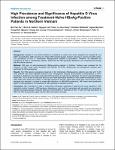High Prevalence and Significance of Hepatitis D Virus Infection among Treatment-Naïve HBsAg-Positive Patients in Northern Vietnam
Sy, Bui Tien
Ratsch, Boris A.
Toan, Nguyen Linh
Song, Le Huu
Wollboldt, Christian
Bryniok, Agnes
Nguyen, Hung Minh
Luong, Hoang Van
Velavan, Thirumalaisamy P.
Wedemeyer, Heiner
Kremsner, Peter G.
Bock, Thomas
Background: Hepatitis D virus (HDV) infection is considered to cause more severe hepatitis than hepatitis B virus (HBV) monoinfection. With more than 9.5 million HBV-infected people, Vietnam will face an enormous health burden. The prevalence of HDV in Vietnamese HBsAg-positive patients is speculative. Therefore, we assessed the prevalence of HDV in Vietnamese patients, determined the HDV-genotype distribution and compared the findings with the clinical outcome. Methods: 266 sera of well-characterized HBsAg-positive patients in Northern Vietnam were analysed for the presence of HDV using newly developed HDV-specific RT-PCRs. Sequencing and phylogenetic analysis were performed for HDV-genotyping. Results: The HDV-genome prevalence observed in the Vietnamese HBsAg-positive patients was high with 15.4% while patients with acute hepatitis showed 43.3%. Phylogenetic analysis demonstrated a predominance of HDV-genotype 1 clustering in an Asian clade while HDV-genotype 2 could be also detected. The serum aminotransferase levels (AST, ALT) as well as total and direct bilirubin were significantly elevated in HDV-positive individuals (p
Dateien zu dieser Publikation
Keine Lizenzangabe
Verwandte Publikationen
Anzeige der Publikationen mit ähnlichem Titel, Autor, Urheber und Thema.
-
2022-01-14ZeitschriftenartikelEpidemiologie der Virushepatitiden A bis E in Deutschland Dudareva, Sandra; Faber, Mirko; Zimmermann, Ruth; Bock, C.-Thomas; Offergeld, Ruth; Steffen, Gyde; Enkelmann, JuliaMit Virushepatitis A bis E werden verschiedene infektiöse Entzündungen des Leberparenchyms bezeichnet, die durch die Hepatitisviren A bis E (HAV, HBV, HCV, HDV und HEV) ausgelöst werden. Zwar ähneln sich die Krankheitsbilder, ...
-
2022-01-14ZeitschriftenartikelEpidemiologie der Virushepatitiden A bis E in Deutschland Dudareva, Sandra; Faber, Mirko; Zimmermann, Ruth; Bock, Claus-Thomas; Offergeld, Ruth; Steffen, Gyde; Enkelmann, JuliaMit Virushepatitis A bis E werden verschiedene infektiöse Entzündungen des Leberparenchyms bezeichnet, die durch die Hepatitisviren A bis E (HAV, HBV, HCV, HDV und HEV) ausgelöst werden. Zwar ähneln sich die Krankheitsbilder, ...
-
2015-07-06ZeitschriftenartikelOccult Hepatitis B Virus Infection in Nigerian Blood Donors and Hepatitis B Virus Transmission Risks Oluyinka, Opaleye O.; Tong, Hoang Van; Tien, Sy Bui; Fagbami, Ademola H.; Adekanle, Olusegun; Ojurongbe, Olusola; Bock, Thomas; Kremsner, Peter G.; Velavan, Thirumalaisamy P.Background: Occult hepatitis B virus infection (OBI) characterized by the absence of detectable HBsAg remains a potential threat in blood safety. We investigated the actual prevalence, viral factors and genotype of OBI ...

